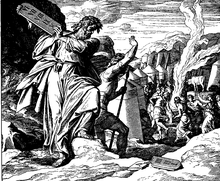Finger of God
| Part of a series on the |
| Ten Commandments |
|---|
 |
| Related articles |

"Finger of God" (
It was also used once by Jesus in the Gospel of Luke to describe how he had cast out demons.[3]
Jews in the tradition of Maimonides posit that anthropomorphism in the Torah, such as the use of body part names, is completely metaphorical, as human bodies are based on potencies of God, not the other way around.[4]
The Finger of God is a phrase used in the Pentateuch or the Five Books of Moses, specifically in the Book of Exodus, to describe an expression of God's power and authority. In Exodus 8:19, Pharaoah's magicians acknowledge the plagues as the finger of God, referring to the harsh natural phenomena that God has brought upon Egypt. The term is also mentioned in Exodus 31:18, where it is said that God wrote the Ten Commandments on tablets of stone with his own finger.
The phrase "finger of God" is used to symbolize the power and might of God and is commonly interpreted by scholars as a sign of His divine intervention and the manifestation of His will. In the New Testament, it is also used metaphorically in reference to Christ's healing power (Luke 11:20). Overall, the Finger of God is a biblical expression that signifies the authority and power of God in the world.
Hebrew Bible
The first time the phrase "finger of God" appears is in the Hebrew Bible, in the eighth chapter, in the paragraph of verses sixteen through twenty of the Book of Exodus, which reads
Then the Lord said to Moses, "Say to
Pharaoh, "This is the finger of God!" But Pharaoh’s heart was hardened, and he would not listen to them, just as the Lord had said.
The second time the phrase "finger of God" appears is at the last verse, verse eighteen of the thirty-first chapter of the same book, which reads "And he gave unto Moses, when he had made an end of communing with him upon mount Sinai, two tables of testimony, tables of stone, written with the finger of God."
The third time the phrase appears is a second reference to the tablets of the
Writing on the wall
The fourth biblical mention is during
- מנא מנא תקל ופרסין
Daniel reads the words "MENE, MENE, TEKEL, UPHARSIN" and interprets them for the king: "MENE, God has numbered the days of your kingdom and brought it to an end; TEKEL, you have been weighed ... and found wanting;" and "PERES, your kingdom is divided and given to the Medes and Persians. Then Belshazzar gave the command, and Daniel was clothed in purple, a chain of gold was put around his neck, and a proclamation was made… that he should rank third in the kingdom; [and] that very night Belshazzar the Chaldean (Babylonian) king was killed, and Darius the Mede received the kingdom."[5]
The phrase the writing on the wall has entered our lexicon from this reference to mean a warning of impending doom.[6]
New Testament
The Greek phrase (Greek: ἐν δακτύλῳ θεοῦ, en dactylō Theou, "by the finger of God")[7][8] is also used by Jesus in the Christian New Testament during his reply to those who said that he cast out demons by the power of Beelzebub. He said, "But if it is by the finger of God that I cast out the demons, then the kingdom of God has come to you."[9]
In the New Testament story of
See also
References
- ^ Exodus 8:16–20
- ^ Exodus 31:18, Deuteronomy 9:10
- ^ Luke 11:20
- ^ Abramowitz, Rabbi Jack (26 March 2018). "Anthropomorphism of God in the Torah".
- ^
ISBN 9780664256753.
- ^ "idoms". The Free Dictionary.
- ISBN 9789004264410– via Google Books.
- ISBN 9783110703870– via Google Books.
- ^ Luke 11:20
- ^ John 8:6
- ^ "Angelus". 21 March 2010. Retrieved 22 October 2018.
